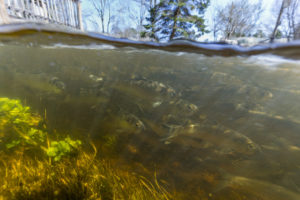
Spring means flowers, songbirds, and the annual upstream migration of river herring to spawn in the streams and ponds they were born in! These historically large migrations of fish into our freshwater streams, rivers, and ponds once supported the Native Americans, the Pilgrims, and the colonists who came after them. They would use the fish as fertilizer for planting and as a food source. But the damming of our streams and rivers to power sawmills and gristmills and then the industrial revolution – there are estimated to be 3,000 dams in Massachusetts alone – caused the first of multiple declines in their once large populations.
In more recent history, further declines have been linked to out-at-sea bycatch by trawlers targeting other similar forage fish like Atlantic menhaden and Atlantic herring. Ecologically, river herring are considered a keystone species, meaning many other fish and birds rely upon them as part of the food chain. Striped Bass in particular like to chase the river herring and feed on them during the spring and right behind them are the striper fishermen!
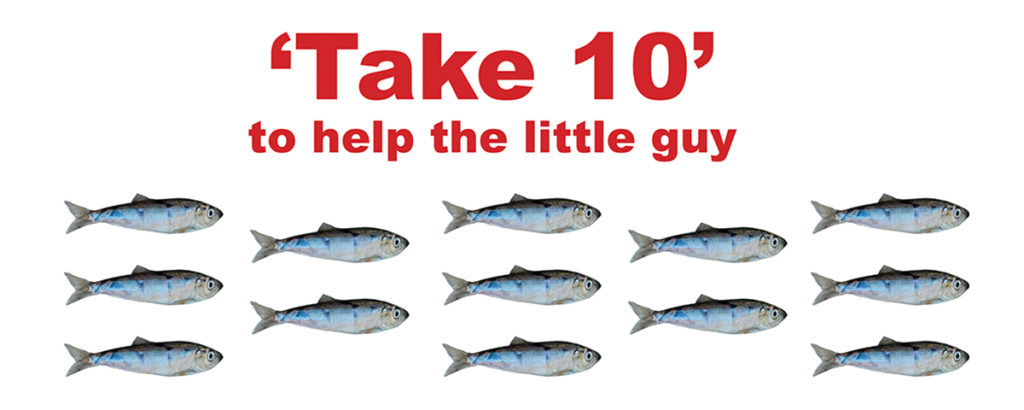 What Can You Do to Help the Herring?
What Can You Do to Help the Herring?
You can become a citizen scientist and “Take 10” to help count River Herring as they return. The NSRWA along with many of our partners such as the Jones River Watershed Association,the Herring Ponds Watershed Association and MassAudubon at Tidmarsh Farms lead fish counts on the South Shore. And if you have kids in school or are a teacher yourself contact us about how we can bring the NSRWA’s FISH School program to a school near you! This free in-school program introduces local students to the life cycle and ecology of river herring, enlists them to become citizen scientists by counting fish passing an underwater camera, and teaches them status of the herring runs in their communities and watersheds. If you and/or your school would like to participate in this program, contact NSRWA’s Environmental Educator Brian Taylor brian@nsrwa.org
The NSRWA and others on the South Shore are working to restore rivers by removing dams that obstruct their migrations and have no other purpose, and working to make fish ladders work better where dams are still required.
Because their populations are at a historic low there is a moratorium on taking of any herring. Please don’t touch or try to catch them. If you see someone catching or harming the fish please tell them to stop or call the Massachusetts Environmental Police at (800) 632-8075.
Where Can You See a Herring Run Near You?
Map link to all fish runs
Sites on the Northern South Shore are ordered by likelihood of seeing fish i.e. highest to lowest returning populations and then sites further South are grouped together.
 Herring Run Pool Park Fish Ladder, Back River, Jackson Square, Weymouth
Herring Run Pool Park Fish Ladder, Back River, Jackson Square, Weymouth
Located behind the Venetian Restaurant in Jackson Square, Weymouth, at the intersection of Broad and Commercial Streets, this unlikely urban pocket park holds one of the most vigorous herring runs on the South Shore, with an estimated population of over 500,000 spawning fish! The run links Weymouth’s Back River to Whitman’s Pond and has been monitored and cared for by Herring Wardens George Loring and Phil Lofgren for decades. The herring run here is largely an alewife run, which prefer to spawn in ponds rather than a blueback herring run, which prefer to spawn in flowing water. Because the alewives’ cue to return is water temperature about 50 degrees, your best bet to see these fish is before the end of April. You can follow George and Phil on Facebook to keep up to date on the latest with this run.
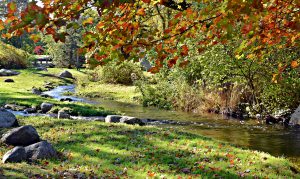 Herring Run Park Fish Ladder, Herring Brook, Pembroke
Herring Run Park Fish Ladder, Herring Brook, Pembroke
The highest population of river herring in the North and South Rivers Watershed, the Pembroke Herring run is best viewed at Herring Run Park in Pembroke off of Route 14. Here the herring have come from Massachusetts Bay, entered into the North River, and have traveled 12 miles from the ocean to the Herring Brook! Gorham Mill, Oldham, and Furnace Ponds are their spawning destinations and they have multiple dams and fish ladders to traverse. This run is well managed by a group of dedicated volunteers – the Pembroke Herring Fisheries Commission. Each year they are responsible for maintaining the flows over the ladders and ensuring there are no obstructions to passage. This run’s population at one time was decimated, but from 1995-1997 it was restocked and the fish population rebounded to at its height in 2023 of ~570,000 fish. Like the Weymouth run, this is largely an alewife run so April is the best time to see the fish here. Monitor our Facebook and Instagram feeds for updates on this run. As of this writing there are thousand of fish visible at the park!
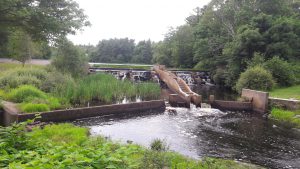 Ludden’s Ford Park Fish Run, Indian Head River, Hanover and Pembroke
Ludden’s Ford Park Fish Run, Indian Head River, Hanover and Pembroke
A great place to take the family, Ludden’s Ford Park at the Indian Head River on either side of the river in Pembroke and Hanover, is where you can view the herring as they wait to enter the fish ladder downstream of this dam. At the right time, thousands of fish can be seen downstream of the dam and ladder. Unfortunately, due to the location of this fish ladder in the middle of the spillway there is no safe way to monitor or maintain the fish ladder as they pass here and we have no idea of their success rate getting past this dam, but we know that the Indian Head River is a potential jewel in the crown of herring runs that could be restored.
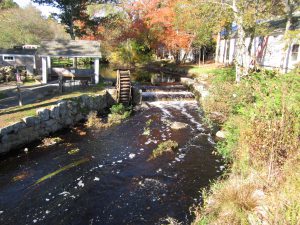 Veterans Memorial Park, South River, Marshfield
Veterans Memorial Park, South River, Marshfield
Located at the corner of Rts 3A and 139 in Marshfield, this beloved park dedicated to our men and women of service has a fish ladder located on the dam. The South River fish run has struggled as the fish ladder is not well designed and requires daily manipulations to allow fish to pass. Our volunteers often note thousands of fish downstream unable to make it over the fish ladder. In 2018, with the daily assistance of the Marshfield DPW and Conservation Commission, more fish were able to pass the fish ladder but they have a short trip upstream because their habitat is limited by other dams at Chandler Pond in Marshfield and Temple St. in Duxbury – neither have a fish ladder. We are currently working to restore the South River with MassBays South Shore, the state’s Division of Ecological Restoration, the towns of Marshfield and Duxbury, the Veterans, and private dam owners, to remove dams as they no longer serve their original purpose.
Currently the best time to see fish at this site is in May and even into June as the run is predominantly blueback herring who prefer warmer water temperatures.
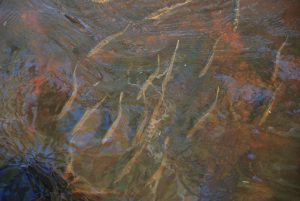 Third Herring Brook, Norwell and Hanover
Third Herring Brook, Norwell and Hanover
The Third Herring Brook runs 5 miles from the North River all the way to Jacobs Pond with multiple tributaries along the way. There used to be 4 dams on this brook and we have removed three and in 2022 we removed 2 weirs that could impede fish passage at low flows. Our ultimate goal is to get the fish back into Jacobs Pond. The three dam removals so far have opened up 9.7 miles of stream for spawning fish! We are most eager to see their populations rebound. Even before the dams were removed, however, one could see hundreds of blueback herring as they returned just below where River and Broadwater Street cross the brook, which also is the town line between Norwell and Hanover. There is a pull off at this location where you can park and then carefully cross the street to the other side to look down as the fish congregate before passing under the road. Best to visit this site in May as this is largely a blueback herring run and they run later in the season.
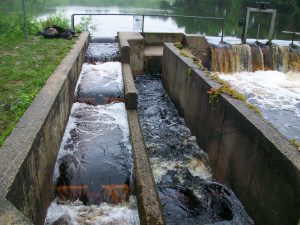 Old Oaken Bucket Pond Fish Ladder, First Herring Brook, Scituate
Old Oaken Bucket Pond Fish Ladder, First Herring Brook, Scituate
This fish ladder connects the estuarine Herring River downstream to the First Herring Brook impoundments (ponds made by dams) upstream. The impoundments are reservoirs for the town of Scituate’s drinking water supply. There are two dams and two fish ladders on the First Herring Brook. The first dam from the ocean is at Old Oaken Bucket Pond off of the Route 3A rotary. You can park at the Stockbridge Grist Mill across the street on Old Country Way or you can park at the town water department offices, walk over to the park next to the pond, and walk to the fish ladder as the pond exits into First Herring Brook.
Unfortunately, this is a run whose population is so low that you are unlikely to see fish – that being said you might get lucky! The NSRWA has been working with the town to restore this fish run since 2007, and to conserve water in the summertime when water demand can more than double, to improve the success rate of streamflow releases in the fall.
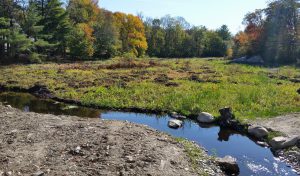 Beechwood Street Fish Ladder, Bound Brook, Cohasset
Beechwood Street Fish Ladder, Bound Brook, Cohasset
Bound Brook connects the Gulf River to the Cohasset’s Aaron River Reservoir and Lily Pond. In late 2017, a dam at Mordecai Lincoln Road, on the Scituate and Cohasset border, was removed in an effort to restore this depleted run. You can look for herring as the brook runs under Mordecai Lincoln Road, but there is no formal parking and it is a narrow street so be careful. You might have better luck upstream as the brook goes under Beechwood Street, where we have had some reports of fish congregating before they went through the culvert and up the fish ladder into Lily Pond, and then ultimately the Aaron River Reservoir. Again no formal parking here and you have to stand on the edge of the road to look over into the water below so be careful.
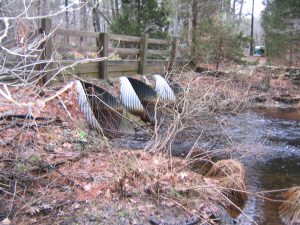 Second Herring Brook, Norris Reservation, Norwell
Second Herring Brook, Norris Reservation, Norwell
The Second Herring Brook runs through the Norris Reservation owned by the Trustees. This run is now fairly depleted and not monitored. The best chance of seeing herring at this site is in May, as the fish are bluebacks who run later in the season in the flowing waters downstream of the Gordon Pond dam. Stand on the dam and look downstream in May and let us know if you see any! It is a nice walk through the beautiful Norris Reservation even if you don’t. Unfortunately, there is not a good solution to expand the spawning area above the dam at this time, as the pond is beloved and the dam is not appropriate for a fish ladder.
Weir River Foundry and Triphammer Ponds Fish Ladders, Hingham
Once home to a thriving herring run now only a few seem to return. The Native Americans and colonists used weirs to catch herring here thus the name of the river. The Weir River runs through Hingham, starting at Accord Pond and ending at the Weir River Estuary between Hingham and Hull. The run here is impacted by upstream water withdrawals for the towns of Hingham and Hull that lower streamflow in the summer and fall when juvenile herring are out-migrating, and like many fish ladders that were placed on old dams, this one is not ideal for fish passage. There are fish ladders at both Foundry and Triphammer Ponds. Access to the Foundry Pond fish ladder is through Hingham Conservation land off of Weir St in Hingham. The Weir River Watershed has had fish counts in recent years at the Foundry Pond Ladder and still only a handful are seen returning, but you never know you might just get lucky!
A Little Farther South
Jones River, Kingston
The Elm Street dam and fish ladder on the Jones River and the Wapping Road dam are no more due to the efforts of the Jones River Watershed Association to restore their river and reconnect it to its headwaters at Silver Lake, so now they count at Forge Pond and Soules Pond fish ladders. Directions and further information on how you can help to monitor for herring can be found here.
Jenny Grist Mill, Town Brook, Plymouth
The Town Brook in Plymouth is a herring restoration success story! Multiple dams have been removed along the Town Brook as well as other fish passage improvements and herring populations have begun to increase. The Town Brook was used by the Pilgrims as their first water supply and provided them, as well as the Native Americans, with herring that fertilized their beans and corn, as well as provided food to sustain them. The Jenny Grist mill is a picturesque setting to view river herring as they return along Town Brook to their ultimate destination at Billington Sea. There is even a walk along the brook to enjoy!
Herring Run Recreation Area, Monument River, Bournedale
If you want to take a ride south, this is a great area to view herring as they return to the Monument River on their way to Plymouth’s Great Herring Pond. There is also an interpretive trail, an interactive learning center, and the Cape Cod Canal Scenic Bikeway to make the trip a full day with your family! Check out the Buzzards Bay Coalition listing of this site!
